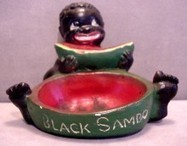George sent in this vintage greeting card…

Along with the following information:
I have a stereotype birthday card from Canada.
It is approx. dated between 1916-1931 by William E. Coutts Co. Ltd.
On the front printed: HAPPY BIRFDAY
(with caricature of small dark child with bright red lips, bow in hair, in dress, holding Good Wishes cards)
GOOD WISHES AM EXACTLY WHAT I SENDS YOU ALL I’SE GOT
OF (and inside card printed, with same picture of girl in
a shy, flirting pose)
‘CAUSE LIKIN’ YOU IS SOMETHIN’ DAT I DOES A POWERFUL
LOT OF!
(Signed by Tiny)
On the back of card, COPYRIGHT WM. E. COUTTS CO.
LIMITED TORONTO, CANADA 5 B 103
Coutts came to Toronto in 1895. In 1916, he founded the William E. Coutts Company, Limited. In 1931, Mr. Coutts entered into a gentlemen’s agreement with Mr. Joyce C. Hall of “Hall Brothers Inc.” and then purchased 40% interest in the William E. Coutts Company, Limited in 1948. The Hall Brothers Company became Hallmark Cards Inc. of Kansas City, Missouri, one of the world’s largest privately held companies.
It is unusual for a black stereotype card to come from a large greeting card company from Canada besides the USA. I cannot find any other Canadian racist examples like mine.
Contact me when you can.

As I told George, most of my cards of this nature I’ve sold. (It’s not just a “make money” thing; I feel these items are better off in the collections of those persons more dedicated to preserving their own history. Yeah, and as a white person, I not only feel that guilt many white people do, but I’m uncomfortable with the idea of being found with such things in my possession — will others know I’m preserving history, or just think I’m a racist who “likes” the things? So unless the items fit into my other areas of collecting, I move them on to other collectors.) But I have made a number of blog posts about racist items (both items I’ve owned and those I’ve found on the web); most of them can be found at my Kitsch-Slapped blog, under the category Colorful Prism Of Racism.
Yet George’s comment about the US having produced more racist or stereotypical greeting cards is intriguing… I don’t know if that’s a purely anecdotal statement base on what George has seen, or if there’s some data behind it. But it’s an interesting perspective. We Americans sure have a problem accepting our difficulty with race — then and now.
As I noted in my review of The Very Best from Hallmark: Greeting Cards Through the Years, by Ellen Stern, there was no admission of any racist Hallmark greeting cards — and very few cards featuring people of color period. So the documentation of our racist history is probably best left to collectors who are more interested in cultural history than in preserving a pristine corporate image.
Which reminds me that as Americans, we resist calling racist cards what they are, racist. Instead, we call racist depictions of African-Americans “Black Americana.” ( Do Canadians use “Black Canadiana”? I don’t know; you Canadians will have to tell me.) Is it more or less respectful to use such a term?
However, even if using such an intellectual term to white-wash the racist reality of the past seems almost as pejorative as the words and illustrations used, at least it’s some sort of (sideways) recognition. Other racist, prejudicial or stereotypical depictions of races and ethnicities are referred to as “not PC” or “not politically correct,” as if it was just a minor social faux paus that was made. (Ditto gender stereotypes.) So maybe the term “Black Americana” is better than that. I don’t know…
But in any case, help George and I out here.
Share your knowledge and observations on racist and stereotypical vintage greeting cards (and other items too). George is especially interested in Canadian cards, but I’d love to hear from collectors in all countries. What do you call this category of collecting? Did America produce the most of these items?
Share your thoughts in the comments. Give us links to your posts on this area of collecting. Send me your images and comments via email (Deanna.Pop.Tart@gmail.com). Do all of the above!










